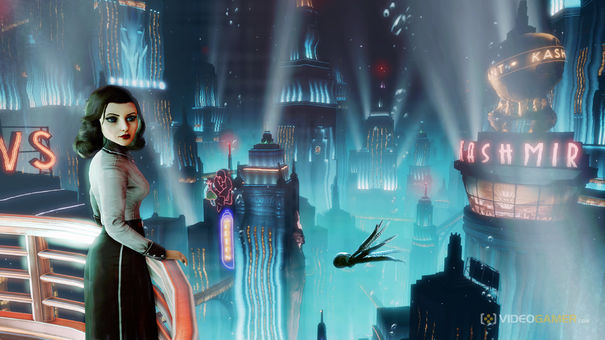

Sony's PlayStation Vita is the Hughes H-4 Hercules of all handhelds; the Airbus A380 to Nintendo's Cessna and Apple's Learjet. Taking a leaf right out of the 'whack everything in just because we can' school of thought, the Vita's hardware credentials are best explained by listing what it doesn't have, rather than what it does. And the answer to that flip-reversed question, it would seem, is "nothing at all," – there aren't any in-vogue hardware trinkets that the PS Vita isn't packing, and it even manages to add one or two of its own original ideas such as the oh-so-sexy and wickedly sensual rear touch-panel. Gadget heads rejoice! This is the hot-rod of handhelds you've been lusting after ever since Atari had the Lynx put down in 1994.
So why, then, does it all feel so familiar? Why do launch titles such as WipEout 2048 and Everybody's Golf feel almost identical to their PSP equivalents of 2005? Excluding the obvious generational leap in visuals, you may as well be playing the same two games in each case. Despite the bountiful array of new control methods, from a capacitive touch-screen to Sixaxis motion sensing, why does the Vita still feel uncannily like playing a PSP with its graphics chip gone nuclear? Perhaps the most practical improvement comes from a second analogue 'nipple', the lack of which had become a bugbear of core PSP gamers over the last seven years. At least now they can play their Call of Duties and Killzones without the sensation that they're in a formative id shooter.
But as someone who proudly purchased a PSP on its European launch day, as well as copies of WipEout Pure and Everybody's Golf alongside it, I felt a vague sense of déjà vu when I first sat down with the PS Vita. And it was more than just the regular disappointment of a next-gen console that fails to live up to the hype, with promises of mind blowing graphics and new ways of gaming going oh-so-predictably unfulfilled. This time it was a genuine sense of confusion and bewilderment that I seemed to be back in precisely the same situation; a situation I'd first encountered on September 1, 2005. Even beyond the familiar games and console design, yet again Sony had produced a handheld that conversely lent itself to extended, sit-down gaming sessions and barely managed to fit in your pocket anyway. Once again, Sony was outdoing its competitors by serving up visuals that were two-thirds of the way towards what it currently offered on its home platform, but failing to best the rest of the market in terms of accessibility and instantaneousness.
Unable to locate a similar example of such disappointment in memory of console launches, I did what I always do in these moments of anomie and existential abandon – I turned to science. Why exactly was I experiencing this sense of déjà vu? Perhaps it would be worth checking that it was definitely the new handheld console, rather than me, that was bonkers. My initial research revealed that the term déjà vu was coined by French researcher Emile Boirac in 1876, and literally translates to "already seen" in English. So far, so obvious. Depending on the survey, statistics have shown that 30 to 90 per cent of the population has experienced déjà vu at one time or another, although the most reliable research posits a figure of around 70 per cent. Ask around your friends and you'll be sure to find that the phenomena is pretty ubiquitous, particularly in people under 30.
The scientific theories and explanations can be just as wide ranging as the statistics, however. At the most extreme end of the scale, there's been quantum physicists who have theorised that tachyons (theoretical sub-atomic particles that travel faster than the speed of light, and therefore back in time) are sending us packets of information from the future that our brains are capable of picking up on, resulting in that eerie feeling of prescience that's common with déjà vu. Building on this, recent experiments at CERN have revealed evidence of neutrinos travelling at faster-than-light speeds, prompting suggestions that these neutrinos could also explain the theoretical tachyons. Nevertheless, the consensus among quantum physicists is that using such theories to explain déjà vu is fanciful at best, as Dr. Michio Kaku (the founder of String Field Theory) diplomatically explains in this video regarding similar suggestions of déjà vu and multi-verses:
In any case, these theories are about messages that may be coming from the future or, indeed, a parallel universe. I'm fairly certain that my particular experience was originally rooted in this universe roughly six-and-a-half years ago. And so onto psychology, where things start to become a little clearer and, paradoxically, more complicated. It turns out there are actually different kinds of déjà vu according to Swiss researcher, Arthur Funkhouser (in a weird turn of events, this guy has three separate profiles on Linkedin, which is even weirder given what I'm about to explain). Funkhouser stipulates that there are three different strands of déjà vu: déjà vécu ("already experienced"), déjà senti ("already thought"), and déjà visité ("already visited"). Respectively, this means perceiving the present as something that's happened to you before under exactly the same circumstances, experiencing it as something you may have dreamt about or considered previously, or finally as somewhere you feel like you've visited in the past.




 Starcraft2 3v3 Combinations
Starcraft2 3v3 Combinations . GOTY 2014 – Chris Bratt
. GOTY 2014 – Chris Bratt The Witcher 3: Wild Hunt Guide
The Witcher 3: Wild Hunt Guide Pokemon X & Y Guide: Pokemon in Route 5 - Versant Road - GamersHeroes
Pokemon X & Y Guide: Pokemon in Route 5 - Versant Road - GamersHeroes Lost Planet 3 Achievements & Trophies Guide
Lost Planet 3 Achievements & Trophies Guide